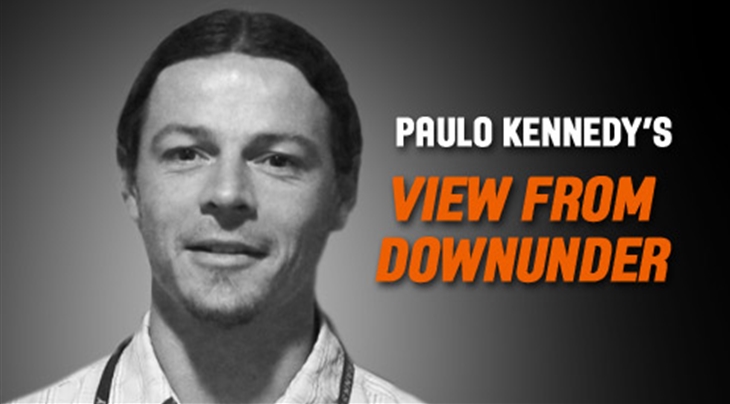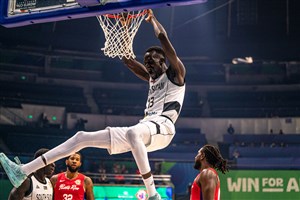
An intriguing drawing board
MELBOURNE (Paulo Kennedy's View from Downunder) - Two different teams, both searching for an identity that will probably be quite different from what they had planned just months ago.
When the draw for the FIBA Basketball World Cup was completed in February, it was hard not to think of the possibility of Oceania placing two teams in the top eight for the first time at a major championship.
Nothing can be taken for granted at a world cup, but the talent and familiarity in both squads meant the opportunity was there to be taken.
Both coaches had a distinct style they wanted to play, styles that would give teams from other parts of the world issues they weren’t too familiar with.
But as Andrew Bogut, Patty Mills, Steven Adams and Alex Pledger pulled out of their respective teams, the coaching staff of Australia and New Zealand were forced back to the drawing board.
For New Zealand's head coach Nenad Vucinic, it was a case of back to the future - the Kiwis are used to being undersized - but the trick is filling that centre hole without the imposing presence of Pero Cameron on-court.
The one that really intrigues me, however, is the selection process Andrej Lemanis and his staff went through to arrive at their final 12 for Spain 2014.
Lemanis has made no secret of his desire to play a different style than predecessor Brett Brown - more disruption on defence, more push of the ball on offence, and more discipline about when and where shots are taken.
Of course, the offensive side of that equation is largely dependent on the defensive side.
Without forcing turnovers or out-of-rhythm shots, it's hard to run and it's hard to create the flow into your offence that allows the rate of ball movement Lemanis envisions.
The good news was the Boomers squad contained three outstanding full-court defensive guards in Mills, Damian Martin and Matthew Dellavedova.
The length of Joe Ingles and Brad Newley on the wings fit the bill, while the power of Nate Jawai and Aron Baynes offer rim protection.
If Bogut had been available he would have perfectly rounded a line-up tailor made for Lemanis' system.
But it was the loss of Mills, the Boomer who draws the most attention from opposition defences, that really changed the balance.
Where a number of defence-first players could have moulded nicely around Mills, Ingles, Dellavedova, Dave Andersen and Co, now all of a sudden the line-up looked light-on for scoring.
Hence, when the Boomers final 12 was chosen, in every position where there were multiple options to choose from the offensive-focused player found himself on the plane to Spain.
At the all-important mobile power forward position, Brock Motum was chosen over defensive specialists Mark Worthington and Lucas Walker, despite his deficiencies on the other side of the ball.
Regardless of his inconsistent first professional season, Motum has an uncanny knack for putting the ball in the hole, but unless he makes serious defensive strides in the next month, disruption early in the shot clock will be difficult for the Aussies.
Adam Gibson was chosen over Martin as the back-up point guard in their seemingly perennial battle.
Gibson is an excellent defender, and he and Martin are often described as similar players, but in truth there is a significant difference in how they defend.
Strong and dogged, Gibson is a standout half-court defender who can lock down a quality opponent even when sets are run specifically for them.
Martin is adequate in this area, but he is elite even by world standards when it comes to disrupting all facets of the offence from the first second of the shot clock to the last.
Gibson's selection could be read as Lemanis preparing to play more steadfast, half-court defence, and may also suggest he is searching for more offence to replace Mills' contribution.
The same could be said about the inclusion of two three-point shooting wings in Chris Goulding and Ryan Broekhoff.
Both are very capable players, but the selection of both instead of taking a full-court defensive specialist like Martin, Worthington or Walker tells a tale about the coaching panel’s thinking.
So what is the plan?
Are the Boomers moving away from Lemanis' preferred game style? Is the new boss confident he can get an offensive-minded team playing the disruptive defence he covets? Or has this team been picked as much for the Rio Olympics as Spain 2014?
When you consider Broekhoff and Motum are just 23 - compared to Martin (29), Worthington (31) and Walker (29) – and will cut their teeth alongside raw but quickly developing teenager Dante Exum, there is a strong case for the latter.
No one had any doubts about how the London Olympics' top quartet - USA, Spain, Russia and Argentina - would play the game. Familiarity with the game-plan and teammates are two of the most important ingredients for success at the highest level.
I love how the Boomers are talking the talk about medals - a talented young group full of belief - but is this realistic for a team still working out the fundamental parts of its identity less than a month out from the world cup opener?
It's not mission impossible, but it's close.
In contrast, after nine lead-up games and at least five world cup outings, this group will be far more expert playing the Boomers new defensive style.
With Mills and Bogut back on board in 2016, they will be a real chance of achieving big things, and I think that explains a significant part of Lemanis and Co's final selections.
Paulo Kennedy
FIBA
FIBA's columnists write on a wide range of topics relating to basketball that are of interest to them. The opinions they express are their own and in no way reflect those of FIBA.
FIBA takes no responsibility and gives no guarantees, warranties or representations, implied or otherwise, for the content or accuracy of the content and opinion expressed in the above article.


















